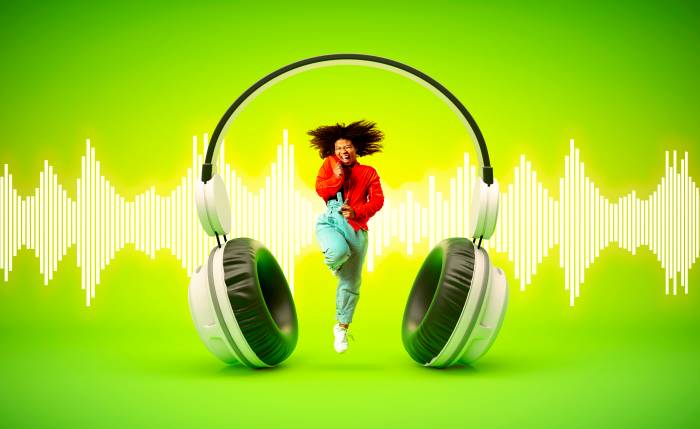Need safe audio and video download tips? Get ways to save files offline. Know the risks, like bad software. Stay safe always. Read our post now for help!
1. Understanding Audio and Video Download
What is audio and video download? Let me make it simple. You save music files. You save video files. You get them from the web. They go onto your device. Like your computer or phone.
You do not stream them. Streaming needs the web all the time. Downloading means you keep a copy. You own that copy on your device. So, you can watch or listen anytime. You can do this even with no web access.
Why do we search for ways to download videos and audio? For many good reasons. It is very easy. It helps when you have no web access. I find it great for long trips. Like on a train or plane. The web signal is often bad there. Downloads mean I always have something to watch or listen to.
How do you download? It can be different. Some sites have clear download buttons. They let you save the file. Other times, you may need a tool. Like software or a web add-on. These tools help with audio and video download from tricky sites. But you must be careful with these tools.
Finding your way with audio and video downloads means being smart. It has good points, but you must know the rules and the risks to your safety. Always check where files come from and know the rules for that site. Using safe methods keeps your device safe. It also respects the people who made the content. I always try to put that first.
2. Why People Seek Audio and Video Download Options
A big reason for audio and video downloads is offline use. Streaming is great. But we know it needs the web. Downloading puts your shows or music on your device. They are ready for that camping trip. Or that subway ride with no signal.
Saving data is also a big plus. This helps a lot with phone plans. HD video uses tons of data when you stream. Doing an audio and video download once on Wi-Fi saves data. You can play the file many times. You won’t use more data.I once got stuck on a lengthy train ride. The signal was awful. I had downloaded some podcasts before I left. That saved me from being so bored!
Here is a simple chart. It shows why downloading helps:
| Feature | Online Streaming | Offline Audio and Video Download |
| Web Access | Need it all the time | Not needed after download |
| Data Use | High (for HD/Good Sound) | Used only once |
| Using Files | Need web access | Use anytime, anywhere |
| Data Cost | It can cost more on some plans | Cheaper to play again |
| What You Have | The list can change | Your lasting library |
Making your library is a strong reason too. Files on streaming sites can go away. This happens when deals change. It can make you sad. Using audio and video download means you keep files you love. They are always there for you.
And think about buffering. That annoying stop when streaming lags. Downloaded files play smoothly. They play right from your device. No stops. No waiting. That smooth play makes audio and video download great if you hate stops like I do.
3. Legal Considerations for Audio and Video Download
When you think about audio and video download, think about the law. It is very important. The main law is copyright law. This law protects creators. Like musicians and movie makers. Downloading their work needs their okay. If you don’t have it, it is often illegal.In most places, it violates copyright laws.
So, always check the source. Where do the files come from? Safe places for audio and video downloads are official sites. Like artist pages on Bandcamp. Or stores like iTunes. Or apps like Spotify or Netflix. These apps have special, approved download buttons. Using random sites or tools to get files from YouTube? That often breaks their rules. And it breaks the law.
You might hear about “fair use” with audio and video downloads. Be careful. Fair use is tricky. It usually means using files for reviews. Or news, or school work. It does not usually mean just downloading a song to listen to. It’s a complex part. Using it for personal downloads is often wrong. And it is risky.
Breaking these rules can cause trouble. Your web provider might send warnings. You could face legal action. That might cost a lot of money. Also, many sites with illegal audio and video download files hide bad software (malware). Stick to legal ways. It keeps you safe from lawsuits. It keeps your devices safe, too. That is always the best plan in my view.
4. Common Methods for Audio and Video Download
You have a few ways to do audio and video downloads. Each way has good and bad points. One way is special software. You put it on your computer. These programs often do more. Like downloading many files at once. Or change file types. Or work faster. They help if you download a lot.
Another common way is web add-ons. These plug into Chrome or Firefox. They often add a simple button. You click it for audio and video download if the media is on the page. This seems easy. But be careful. Only install from official stores. Check reviews. Some bad add-ons hide malware.Or they monitor your online activity.
Then there are download websites. You usually paste a web link (URL). The site finds the file. It gives you download links. You don’t install software. But I warn you: be careful here. Many sites have tons of ads. Or fake buttons. Or safety risks. Finding a safe site for audio and video downloads needs you to check closely.
Last, remember official downloads in apps. Many services you pay for let you download. Netflix, Prime Video, and Spotify do this. You download it inside their app. You can watch or listen offline. This is usually the safest audio and video download way. It follows the rules. But you can often only play the file inside that same app.
5. Top Websites and Tools for Safe Audio and Video Download
Finding safe ways for audio and video downloads needs care. Many bad sites exist. Your safest path is official sites. Think about artists selling music on Bandcamp. Or digital stores like Amazon Music. Or free photo/video sites like Pexels. These places give you clear permission to download.
What about other tools for audio and video download? Like software, add-ons, or online sites? You must choose wisely. Look for tools with good names. Read what users say. Check their privacy rules. I always look at tech review sites first. I get nervous if a tool asks for weird permissions. Or if it tries to install extra junk I don’t want.
This table shows what to look for:
| Tool Type | Good Signs to Look For | Risks if Not Safe |
| Desktop Apps | Known maker, good reviews, safe options | Bad software, spies, and extra junk ads |
| Web Add-ons | From the official store, clear permissions | Steals data, messes up web use, and malware |
| Online Sites | Safe web link (HTTPS), a few bad ads | Bad ads, fake links, and virus downloads |
| Official Apps | Built-in feature (like Netflix), follows rules | Usually very safe, but limited to the app |
Always check before you use a tool for audio and video download. Stay away from sites with too many pop-ups. Or fake virus alerts (a bad trick!). Or links that send you somewhere strange. Keep your anti-virus software working. It adds a needed safety layer.
Really, using official downloads or buying files is safest. It avoids headaches. If you do try other tools for audio and video download, be super careful. Check everything. Do not risk your safety or break rules just for a file. Trust me, it’s not worth the trouble.
6. Risks Associated with Unsafe Audio and Video Download Practices
Let’s be honest. Unsafe audio and video downloads are risky. The biggest risk is bad software (malware). Many shady sites hide bad stuff in free downloads. Like viruses. Or ransomware that locks your files. Or spyware that steals info. You click download. You open the file. Boom. Your device is hit. They might steal passwords. Or bank info. It’s a bad dream!
Besides tech risks, there are big legal risks. Unauthorized audio and video downloads are illegal. We talked about this. Copyright owners watch for this. They can take legal action. This might mean big fines. It does happen to people.
You also risk getting bad files. Illegal audio and video download sources often give junk. Files might be of low quality. Or glitchy. Or not complete. Or not even the file you wanted! I heard of people getting malware hidden in a fake movie file. What a waste of time. And so unsafe!
And think about the bad sites themselves. They often have tricky ads. Fake “download” buttons are common. Pop-ups try to fool you. They want you to install bad software. Or give up personal info. Using these sites feels dangerous. Safe, legal audio and video download ways are much better for your peace of mind.
7. Audio and Video Download on Different Devices (Desktop vs. Mobile)
How you handle audio and video downloads can change. It depends on your device. Is it a desktop computer? Or a portable gadget like a tablet or phone? Desktops usually give you more choices. You can find more powerful download tools for PC or Mac. These give you more control.
Mobile devices have more limits. iPhones and iPads have strict App Store rules. It is harder to find third-party apps for general audio and video downloads. Official apps (like Netflix) work well for downloads inside their service. But finding tools to download from anywhere is tough. Android is a bit more open. But getting apps from unknown places adds safety risks. Be careful.
Storage space is key, too. This matters most on mobile. HD videos are big files. They fill up phone space fast. Managing your downloads needs more care on mobile. My desktop has a big hard drive. Building a large offline library using audio and video downloads feels easier there.
How you use it matters, too. Mobile apps often have simple touch screens. Desktop software might have more buttons. It might seem more complex. Picking a desktop or a mobile for audio and video downloads depends on you. What do you need? How much space do you have? What feels easiest for you?
8. Choosing the Right Format for Your Audio and Video Download
When you do an audio and video download, you often pick a file type (format). Picking the right one is key. It affects quality. It affects file size. It affects whether your device can play it! Knowing the basics helps you choose well.
For audio, MP3 is very common. It plays almost everywhere. It uses ‘lossy’ compression. This means some sound data is lost to make files small. But most people think that high-quality MP3s sound fine. AAC is another common lossy type. Apple uses it a lot. It can sound a bit better than MP3 at the same size. Want the very best sound from your audio and video download? Lossless types like FLAC keep all sound data. But the files are much bigger.
For video, MP4 is the top choice for playing anywhere. The majority of gadgets and web browsers can use it. It gives good quality for its file size. It often uses H.264 or H.265 video with AAC sound. I once did an audio and video download of a movie in MKV format. My old tablet could not play it! Since then, I usually pick MP4 to be safe. Unless I know my device plays MKV well. MKV can carry a lot of tracks, such as subtitles. Older types like AVI are less used now.
So, picking a format for audio and video download means finding a balance. Need it to play everywhere? Need to save space? MP4 is a decent choice for video and MP3/AAC for audio.Want the very best quality? Got lots of space? FLAC for audio and high-quality MKV/MP4 for video might work. Just think: where will I play this file?
9. Tips for Optimizing Your Audio and Video Download Speed
Slow audio and video download speeds are no fun. But you can often make them better. First, check your web connection. Is it steady? Is it fast enough? Using a cable (Ethernet) to your router is often faster. It is more stable than Wi-Fi. particularly if the router is far away.
Where the file comes from matters too. If the server is busy or far away, downloads will be slow. Some download tools can speed up audio and video downloads. They make many connections at once. This can help with big files. But the server must allow this.
Think about your device, too. Close other apps or web tabs. Things using the web can slow down your active audio and video downloads. Like streaming video. Or cloud backups. Or system updates. I sometimes pause my cloud backups if I need a big file fast.
The tool you use can also change the speed. Some download software works faster than basic browser downloads. Also, think about when you download. The web is often less busy late at night. Or early in the morning. Trying your audio and video download, then it might make it much faster.
10. Troubleshooting Common Audio and Video Download Problems
We all hit problems with audio and video downloads sometimes. One common issue: the download fails. Or it stops halfway. This might be your web connection. Or a server issue. Or maybe your computer went to sleep. Try starting the download again. Check your web signal. Make sure the link still works.
Sometimes you get an error. Like “file not found.” Or “bad link.” This often means the file was removed. Or the link is old. Or you copied the link wrong. Verify the URL you used to download the audio and video.Try going to the main page. Verify whether the file is still present.
What if the file downloads okay but won’t play? Or does it look broken? That’s annoying! It could be a glitch during download. Or a bad source file. Or perhaps the format is too complicated for your media player. I have had this happen! Trying a different player usually works for me. Nearly all audio and video downloads can be handled by the free VLC player. Downloading again might also help.
File type problems are common, too. You download a file. Maybe MKV video or FLAC audio. Your default player says no Using a player like VLC often fixes this. Or, some download tools can convert files. They can change your audio and video downloads to MP4 or MP3. Then it should play fine on your device.
11. The Future of Audio and Video Download Technologies
How we do audio and video downloads keeps changing. Streaming is very popular now. New tech also changes things. Streaming is great for quick access. But we still need files offline sometimes. So downloading is still needed. It is just changing. Future tech might make downloads faster. Or smarter. Or link them more to cloud storage.
We might get better ways to shrink files (compression). This means high-quality audio and video download files could use less space. That would be great for phones! Maybethe download tools will get smarter. They could use AI to guess what you want offline. They might download files at night for you. Or switch networks easily to keep downloads going.
Streaming and downloading might work together more. More services could offer better download options. Like downloads that refresh themselves. Or easy ways to buy and own files inside the streaming app. Some people think peer-to-peer tech might help too. It could speed up audio and video downloads for popular files on legal sites.
But challenges remain. Like digital rights management (DRM). This tech tries to stop illegal copying. As download tools get better, DRM tech also gets better. This push and pull will keep shaping audio and video downloads. It affects how easy it is for us. And how creators protect their work.
12. Alternatives to Direct Audio and Video Download
Direct audio and video downloads help sometimes. But remember: there are many great, legal ways to get media. Official streaming services are huge. There are several shows available on Netflix, Hulu, Prime Video, and Disney+.You watch them instantly online. Many now have safe, built-in download buttons in their apps, too. That’s often the easiest safe way.
For music fans, Spotify, Apple Music, and YouTube Music are great. They have millions of songs. Pay for the premium plan? You can usually download playlists right in the app. Listen offline safely. No need for risky third-party audio and video download tools.
Buying digital media is another good choice. Stores like iTunes, Google Play, and Amazon sell movies, shows, and music. You buy it. You usually get a license to stream or download it legally. You own it (based on their rules). No worries, like with unsafe audio and video downloads.
Also, support creators directly! Sites like Patreon or Bandcamp let artists offer their work. Supporting them often gives you direct downloads. Using these official ways gives you good media. It keeps things legal and safe. That is always better than risky audio and video download ways.
Conclusion
So, let’s sum it up. Audio and video downloads are still handy for many of us. We want offline access. We want to save phone data. We want our own media library. We saw that there are many ways to do it. From official app downloads. To buy files legally. To use other kinds of tools or sites. But, like I said many times, you must be careful. “Free” downloads often lead to danger zones. Full of bad software (malware) that can wreck your devices. Plus, you could face legal issues for breaking copyright rules. My strong advice? Stick to safe and legal ways first. Use download buttons in apps you pay for. Buy from real stores. Find great stuff on sites like Bandcamp or free media sites. Knowing file types helps. Knowing how to fix issues helps. But safety beats everything. Tech will change how we handle audio and video downloads. But being smart, safe, and fair should always be your main goals. Protect yourself. Respect creators.
FAQs.
- Q: What is audio and video download? A: Audio and video download means saving sound or picture files. You save them from the web. They go onto your computer or phone. You can play them with no web access later. (169 chars)
- Q: Is audio and video always safe? A: Safe audio and video downloads require you to be careful. Using official apps or known stores is safest. Bad sites have computer risks like viruses. Check where the files come from first. (182 chars)
- Q: Why do people use audio and video downloads? A: People use audio and video downloads to save media files. They want files to use when not online. This saves phone data costs too. It lets them keep a media list they like. (174 chars)
- Q: What are some ways to download audio and video? A: Some ways for audio and video downloads use apps, software, or websites. Official app downloads are usually safe. Be very careful with other software tools or strange sites you find. (185 chars)
- Q: Can audio and video downloads cause problems? A: Yes. Audio and video downloads of files without permission are often illegal. It breaks copyright rules. Stick to legal ways. Buy files or use downloads approved by the app or site. (183 chars)
- Q:What dangers come with downloading videos and audio from unreliable websites?A: Bad audio and video download sites have big risks. You might get bad software, like a virus. Your info could be stolen. You might face big fines for breaking the rules. Stay safe. (180 chars)









